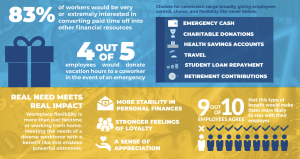Paid time off (PTO). I can say, with some certainty, that it’s the benefit pretty much everyone would agree they want more of. So why is it that the vast majority of employees struggle to take full advantage of it?
This was just one of the questions we sought to get to the bottom of with our It’s Time To Rethink Paid Leave Report – a recently published study that PTO Exchange collaborated on with Lighthouse Research to understand how employees are using (or not using), their accrued PTO benefit.
And the conclusion we have come to is stark: a fundamental reconsideration of PTO policies and offerings is long overdue.
Here’s why:
PTO policies are ineffective and increasingly obsolete

Our research found that just 40% of employees use all their PTO in a given year, while as many as 80% took less vacation time than average during the first year of the COVID-19 pandemic.
At the same time, many employees also reported feeling under pressure to use PTO when they don’t need it. Some three-quarters of workers we surveyed said they’d taken unneeded time off because they didn’t want to lose the vacation they had accumulated.
Both these findings are worrying. it should never be stressful or difficult for employees to enjoy their hard-earned vacation days. Nor should companies have to worry about the unsustainably large balances of paid leave that accumulate when PTO is constantly deferred.
Inequalities revealed
Not only are the above findings worrying, the dysfunctional relationship people have with their leave perpetuates inequality in the workplace.
We found non-white employees were 19% less likely to take all their leave than their white colleagues, while women were 43% less likely to do so than men. Moreover, although 72% of workers earning more than $125,000 pa used all their PTO, this proportion collapsed to 56% for those making less than $49,000.
It’s clear from this that many companies’ current PTO policies don’t provide the flexibility necessary to accommodate an increasingly diverse workforce.
A better way is needed
When employees don’t use the accrued PTO they’ve earned, it creates several organizational risks for companies – from the potential payout of large quantities of vacation time all at once, to the risk of losing employees because of inflexibility.
These are the reasons it’s long past time for companies to rethink PTO for a modern, diverse workforce.
But while the under-utilization of PTO is costing employees millions of dollars in forgone benefits and creating liabilities for companies, it also presents an unprecedented opportunity to rethink the relationship between workers and employers.
Companies that offer flexibility options with their accrued PTO will demonstrate that they’re prioritizing employees’ specific needs and concerns, which will help them retain staff, improve morale and culture, build loyalty and fill open roles.
How to upgrade your PTO benefit

PTO is supposed to benefit employees, but it leaves many scrambling to take unnecessary time off when doing so may be awkward or inconvenient for them – or it simply isn’t used at all.
This is why it’s no surprise that 83% of employees say they’re ‘very’ or ‘extremely interested’ in converting the value of PTO to other resources, such as emergency funds, retirement, health savings accounts, travel, student loan payments, and even charitable donations.
A remarkable 80% of employees also say they would donate PTO to a coworker in an emergency – a form of mutual support companies should facilitate to build a healthier company culture.
It’s worth remembering that employees in different demographic groups don’t just diverge in how much vacation they use – they also have distinct priorities when it comes to repurposed PTO.
For example, while low-income workers say they would like to have some extra cash for emergencies, high-income workers are interested in contributing to health savings accounts. Older employees are disproportionately likely to use converted PTO for retirement savings, while younger employees would use the funds to pay back their student loans.
It is only be allowing employees to use their accrued PTO as they see fit, that HR leaders can ensure vacation days are being put to good use.
The impact of flexibility with accrued PTO
There has been a fundamental shift in the relationship between employees and companies over the past several years. The COVID-19 pandemic and the transition to remote work didn’t just alter employee expectations about how and where they work – it inaugurated a period of extremely high turnover and labor mobility.
These are the reasons companies need to make employee retention a critical priority, and convertible PTO is a powerful resource in this effort. Our research found that giving employees more flexibility with their current accrued PTO benefit would make 70% feel their company valued and appreciated them – a feeling that drives loyalty.
Even more revealing is the finding that 90% of employees said having access to convertible PTO would make them more likely to stay with their companies.
So, at a time when 80% of employees are disengaged at work; when turnover has surged; and the competition for talent has never been more intense, companies must start providing benefits that make employees feel like valued members of the team. By offering flexible options, your HR team has the power to drive engagement, retention and loyalty – a sure way to give your company a major competitive advantage.
